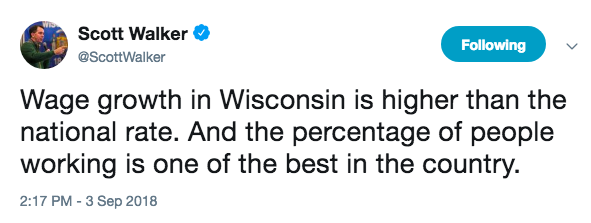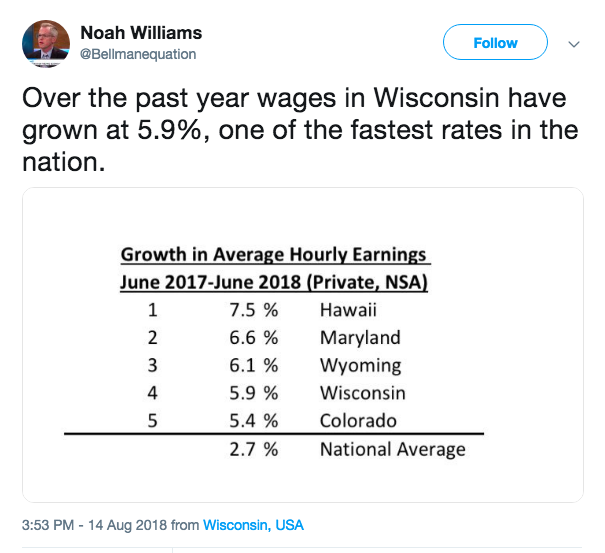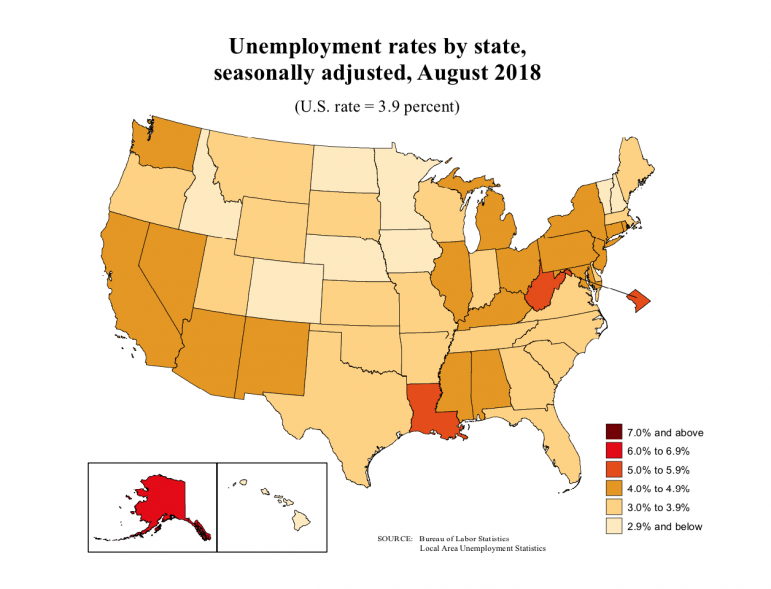In a tweet from Sept. 3, Gov. Scott Walker praised Wisconsin’s economy, claiming “wage growth in Wisconsin is higher than the national rate. And the percentage of people working is one of the best in the country.”
The Observatory checked both claims by Walker.

According to Walker, Wisconsin’s wages are growing faster than the national rate. When asked about the claim, Walker’s campaign press secretary Austin Altenburg referenced a July BizTimes article. From January to May of 2018, Wisconsin experienced a year-over-year increase of 5.7 percent, according to the article. The U.S. average was 2.7 percent.
Altenburg also sent a link to a tweet from University of Wisconsin-Madison economics professor Noah Williams, who said Wisconsin’s wages grew 5.9 percent from June 2017 to June 2018. The national average during that time was also 2.7 percent.

According to the U.S. Bureau of Labor Statistics’ Quarterly Census of Employment and Wages, for the first quarter of 2018, the average weekly wage in the U.S. increased 3.7 percent, and in Wisconsin the average weekly wage increased 3.8 percent.
Because each of these sources looks at a different time frame, the percent increase for Wisconsin and the United States is different. However, no matter the time frame, Wisconsin’s wage growth is beating the national average.
While Wisconsin’s wage growth rate is higher than the national rate, the average Wisconsinite is paid less per week than the average American. Nationally, the average weekly wage was $1,152, and in Wisconsin, it was $968, according to the U.S. Bureau of Labor Statistics.
Moreover, one in five Wisconsin workers has a poverty-wage job, according to UW-Madison’s COWS, a “national think-and-do tank that promotes ‘high road’ solutions to social problems.” COWS defined a poverty-wage job as one that pays less than $11.55 per hour. In Wisconsin, 22 percent of white workers, 41 percent of black workers and 41 percent of Hispanic workers hold poverty-wage jobs.
“Low-wage jobs – indeed, low-wage careers – define and constrain the prospects of too many workers,” COWS found. “And … while racial inequality is not unique to Wisconsin, it is extreme here.”
Despite these caveats, The Observatory rates Walker’s first claim, that the state has experienced higher wage growth than the national average, as Verified.
Walker’s second claim was that the percentage of people working in Wisconsin is one of the best in the country.
The state has a 69 percent labor force participation rate compared to the national rate of 62.9 percent, according to COWS. This is the fifth highest rate in the country.

U.S. Bureau of Labor Statistics
Furthermore, Wisconsin’s current unemployment rate is 3 percent — it’s tied for 10th along with South Dakota and Virginia. The national unemployment rate is 3.9 percent.
Wisconsin’s neighbors Minnesota, Iowa, Illinois have an unemployment rate of 2.9, 2.5 and 4.1 percent, respectively.
But Wisconsin’s low unemployment rate is not the same for everyone. The 2018 COWS report broke down the state’s unemployment rate by race.
COWS found white unemployment was at 2.6 percent, Hispanic unemployment was 5.4 percent and unemployment among African-Americans was 9.3 percent. The black unemployment rate is more than three and a half times the white unemployment rate — the highest disparity in the nation, COWS associate director Laura Dresser said.
“Even as the white unemployment rate is almost the lowest it’s ever been, the black unemployment rate is at levels that we would call a recession,” Dresser said.
In April, The Observatory found that although the state’s unemployment rate was at a historic low, many Wisconsinites have to work two jobs due to low wages.
Overall unemployment is low, and labor force participation is high, but that leaves out the context of high unemployment for black residents. As a result, it does not provide a complete picture of Wisconsin’s economy — especially since the disparity between white and black unemployment is the worst in the nation.
Nevertheless, The Observatory rates the claim of Wisconsin’s high overall labor participation as Verified.
Sources
Tweet from Gov. Scott Walker, Sept. 3, 2018
Email from Walker’s campaign press secretary Austin Altenburg, Sept. 28, 2018
Tweet from University of Wisconsin-Madison economics professor Noah Williams, Aug. 14, 2018
BizTimes, Wage growth in Wisconsin outpacing U.S., July 23, 2018
U.S. Bureau of Labor Statistics, Covered establishments, employment, and wages by state, Aug. 22, 2018
State of Wisconsin Department of Workforce Development, Wisconsin Ranks 1st Nationally in Manufacturing Jobs Added Over Last Three Months, Sept. 21, 2018
Interview with COWS associate director Laura Dresser, Sept. 27, 2018
Bureau of Labor Statistics, Local Area Unemployment Statistics, Sept. 21, 2018
Bureau of Labor Statistics, Unemployment rates by state map, August 2018
COWS, The State of Working Wisconsin, Aug. 31, 2018

